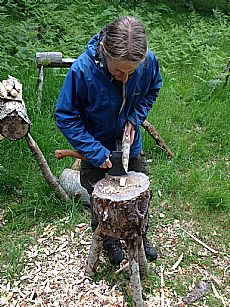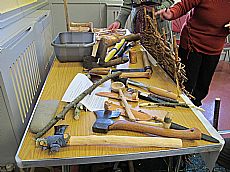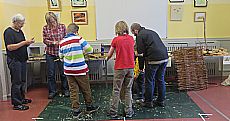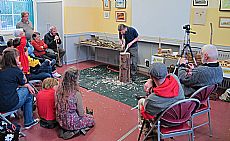Green Woodworking workshop 28-10-2017
Posted by Susan Kruse - 12:37 on 16 November 2017
 ARCH’s new project ‘Experimental Archaeology: learning about technologies in the past’ kicked off on 28th October at Dingwall Community Centre. The project, funded by Historic Environment Scotland and the Heritage Lottery Fund, aims to explore different crafts from the past, in a mixture of demonstrations, discussion and hands-on sessions.
ARCH’s new project ‘Experimental Archaeology: learning about technologies in the past’ kicked off on 28th October at Dingwall Community Centre. The project, funded by Historic Environment Scotland and the Heritage Lottery Fund, aims to explore different crafts from the past, in a mixture of demonstrations, discussion and hands-on sessions.
Lachlan McKeggie gave a great first session for us. Lachlan is an archaeologist with a wide range of experience who became interested in green woodworking. Few objects created from wood survive of course, but the craft must have been a major source of everyday objects from earliest time. Lachlan showed us the differences in working with green wood (freshly cut) and seasoned wood, with green wood being much easier to work, though having some shrinkage as it dries.
Lachlan demonstr ated first how to make a small object – a peg or a mushroom depending on one’s point of view – while he explained some of the background to the sources of wood available to early people, the tools they might have used, and the techniques for making simple objects. He had a stone axe and various metal tools for people to try.
ated first how to make a small object – a peg or a mushroom depending on one’s point of view – while he explained some of the background to the sources of wood available to early people, the tools they might have used, and the techniques for making simple objects. He had a stone axe and various metal tools for people to try.

Participants of all ages had a go and within a short period of time produced their own peg/mushroom. In the second half of the drop in session, Lachlan then showed how the same techniques could be used for making more complex objects such as a spoon. We watched in wonder as he cut a small piece of green wood, and then proceeded to use the same techniques to make a spoon. A few people went on to have a go, and were well on the way to creating a spoon by the end. I also began to wonder when our earliest evidence of a spoon was in Scotland. We have evidence of Iron Age spoons – but given how easy they are to make, it is probable they were much made in earlier periods as well.
 The sessions were great, with most people staying for the full 4 hours! We learned a great deal. Two things stuck in my mind after the session. Knowing the techniques has now led Lachlan to become convinced that some prehistoric objects in the National Museums of Scotland, published as bowls, were in fact failed large spoons (with the handle broken off). These failed objects also provide good evidence of the methods and sequence of actions ancient people used – which is different than some green woodworkers had previously thought.
The sessions were great, with most people staying for the full 4 hours! We learned a great deal. Two things stuck in my mind after the session. Knowing the techniques has now led Lachlan to become convinced that some prehistoric objects in the National Museums of Scotland, published as bowls, were in fact failed large spoons (with the handle broken off). These failed objects also provide good evidence of the methods and sequence of actions ancient people used – which is different than some green woodworkers had previously thought.
Some questions of course remain, many which we can only guess at. The ease of working with green wood, even with early tools, must have meant everyday objects were made on a regular basis – but how many people would have been able to have a stone axe or metal one? Did everyone in a community do green woodworking or was it a specialised task, or one for only men?
All craftspeople leading the Experimental Archaeology workshops will be donating an object either made on the day or finished later, which will form a loans box. Lachlan will provide an arrowshaft, a spoon and a cup.
Further information
Some links to various wooden objects found in Scotland:
- Medieval wooden trough from Durness
- Roman spatula from Stirlingshire
- Early Iron Age objects from Oak Bank crannog, Loch Tay
- Iron Age wooden pegs from Lochlea crannog, Ayrshire
- Iron Age spoon from Lochlea crannog, Ayrshire
Some videos you may find interesting:
Further information about the Experimental Archaeology: Learning about technologies in the past can be found on the ARCH website.
Were you at the event? Share your thoughts!
Add your comment below
- Recent Blog Articles
- Learning Resources
- Crafting Day October 2018
- Medieval Coinage Workshop
- Viking Ring-Money workshop
- Thomas Telford Workshop
- Monthly Blog Archive
- June 2018
- May 2018
- April 2018
- March 2018
- February 2018
- January 2018
- December 2017
- November 2017
